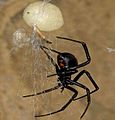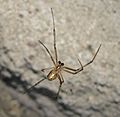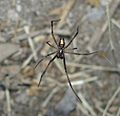Western black widow spider facts for kids
Quick facts for kids Western black widow spider |
|
|---|---|
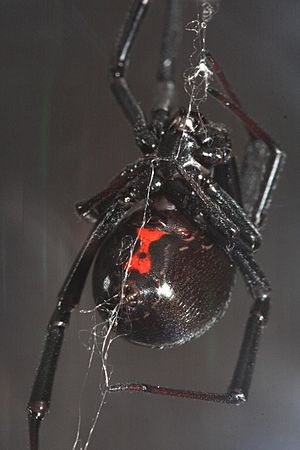 |
|
| Latrodectus hesperus female | |
| Scientific classification | |
| Genus: |
Latrodectus
|
| Species: |
hesperus
|
The western black widow spider, also known as Latrodectus hesperus, is a type of spider that can bite and inject venom. You can find these spiders in the western parts of North America. The female western black widow is about 14–16 mm (about half an inch) long. She is usually black and has a special red mark on her belly that looks like an hourglass. Sometimes, this hourglass mark can be yellow or even white. The male spider is much smaller, about half the size of the female. He is usually tan with lighter stripes on his belly. Western black widows build webs that look a bit "messy" or irregular. Unlike other spiders that make neat spiral webs, the strands of a black widow's web don't seem to follow a clear pattern.
Female black widows have strong venom that contains a neurotoxin. This venom can affect many mammals, including humans. If a human is bitten, they might feel pain, nausea, get goosebumps, and sweat in the area of the bite. In the past, some reports mentioned people dying from these bites, but recent studies have not found any deaths from western black widow bites in the U.S. For example, out of over 23,000 bites recorded between 2000 and 2008, no one died. Sometimes, after a male and female spider mate, the female might eat the male. Male western widows can mate several times during their short lives. They often prefer to mate with females that look well-fed, which they can tell by checking the female's web.
Contents
Where They Live
You can find Latrodectus hesperus in the western areas of North America. In Canada, they live from British Columbia all the way to Manitoba. They are most common near the Canada-U.S. border. You can also find them, though less often, in the prairie regions of Western Canada.
Mating Behavior
When a male spider touches a female's web, it can make her interested in mating, and the same goes for the male. But sometimes, the female spider might not want to mate and will scare the male away.
To make sure mating is successful, the male L. hesperus has a clever trick. He cuts parts of the female's web that he thinks she might use to escape. Once the male touches the female, he wraps her in a special silk called the "bridal veil."
The time they spend mating can be very different. It might be as quick as ten minutes or last as long as two hours.
Hunting and Food
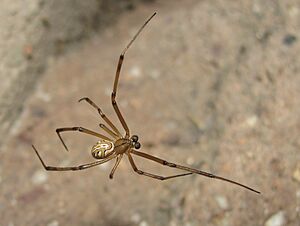
How They Hunt
L. hesperus often hangs upside down in the middle of its web. It waits for insects to fly into the web. Once an insect is caught, the spider bites it and then wraps it tightly in silk. The web has special sticky threads called "gum-footed threads" with liquid glue on them. When prey touches these threads, they get stuck. The thread then breaks, and the prey is pulled up by the web, making it easy for the spider to reach. The web also helps the spider move quickly when attacking prey. From May to October, these spiders catch a lot more prey. This is likely because females are laying egg sacs and their babies need a lot of food to survive.
Finding Good Spots
Female L. hesperus spiders can sense chemicals left by their prey. This helps them decide where to build their homes. If an area has a lot of prey chemicals, the spider is more likely to settle there. Knowing this could help control black widow spiders. If we reduce the number of their prey in an area, the spiders might move somewhere else to find more food.
What They Eat
Like other spiders that build webs, L. hesperus eats many different kinds of prey. They feed on insects from eight different groups of arthropods. In one study in British Columbia, most of their food came from beetles and wasps, bees, and ants. The beetles they ate most often were darkling beetles, weevils, and ground beetles. The most common Hymenoptera were ants, wasps, and bumblebees. These insects were most active from May to September in British Columbia, which is also when L. hesperus ate the most.
L. hesperus might also eat other spiders of its own kind. This happens if there isn't enough other food, if the spider is very hungry, or if they are fighting to defend themselves.
Webs and Silk
Spider Silk
The silk made by L. hesperus is very sticky. It has a strong fiber in the middle covered with tiny drops of sticky liquid protein. If you rub it between your fingers, it feels like rubber. These sticky drops are much bigger than the fiber and you can see them without a magnifying glass.
The silk of L. hesperus is very strong, similar to the silk made by orb-weaving spiders. Its strength is about 1000 MPa. To give you an idea, the strength of mild steel is about 800 MPa.
L. hesperus makes three different types of silk:
- Dragline silk: Used for safety lines and the main structure of the web.
- Inner egg case silk: Used to protect the eggs inside the egg sac.
- Scaffolding silk: Used for the main support structure of the web.
Scientists have studied the chemicals that make up these silks. Both dragline silk and scaffolding silk are mostly made of alanine and glycine. The inner egg case silk also has a lot of alanine, but less than the other silks.
The silk of L. hesperus also contains special chemicals called pheromones. These pheromones act like scents that the opposite sex can detect when they touch the web. Male spiders can find females and start mating behavior because of the female pheromones. Female spiders also become less likely to attack the male when they sense male pheromones.
Web Design
L. hesperus builds what are called cobwebs. Cobwebs are different from the round, wheel-shaped webs you might see. A cobweb has three main parts:
- Gumfoot threads: These hang below the web and have sticky glue to trap prey. When prey gets stuck, the thread breaks, and the prey is pulled up towards the spider.
- Mesh region: This part also helps catch prey.
- Scaffold threads: These provide the main support structure for the whole web.
The spider usually hides in a safe spot where the web starts.
Web Behavior
L. hesperus changes how it builds its web depending on how much food it catches. If the spider is full, it will spend less energy building the parts of the web that are meant for catching prey. This is smart because the spider doesn't need more food right away, so it saves energy. Even though they might build less of the prey-catching parts, the total amount of silk they produce stays the same or even increases. Also, when a female spider is getting ready to lay eggs, she will use less silk for her web and more silk for making egg sacs.
How They Defend Themselves
Black widow spiders have predators, like mice, which are bigger than them and eat many things. Young black widows and adult female L. hesperus can shoot out a sticky, thick silk at animals that might try to eat them. This silk is not poisonous, but it can bother predators and make them go away. However, adult male spiders cannot make this defensive silk. This is probably because they need to save their energy for mating during their short lives. This defense is very important for females, as they are often hunted. Black widow spiders spend a lot of time building their webs late at night, which is also when ground mice are active. If a web is built low to the ground, it's easy for mice and other predators to attack from below. Since the spider usually stays still in the middle of its web, this defense helps it survive these attacks.
Venom
The bite of L. hesperus is similar to other black widow spiders because they are related. The spider uses its fangs to inject venom into its prey or an enemy. For prey, the venom makes them unable to move, which helps the spider digest them later. For humans, the venom acts like a neurotoxin, affecting how our nerves communicate. The female spider is more dangerous than the male, but she usually only bites if she feels her eggs are in danger. Female fangs are larger than male fangs, and their venom glands are also more developed. The effects of a bite can be mild irritation or more serious problems with the body's automatic functions. The venom is made of proteins, peptides, and other chemicals. It causes too many signals to be sent between nerves, which can lead to symptoms like stiff muscles, sweating, and nausea. Treatments for a bite include painkillers, and sometimes antivenom if the bite is very serious.
Gallery
See also
 In Spanish: Viuda negra norteamericana occidental para niños
In Spanish: Viuda negra norteamericana occidental para niños



